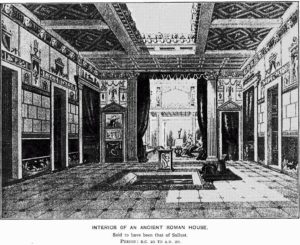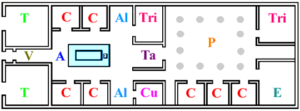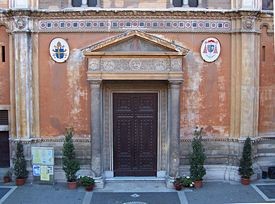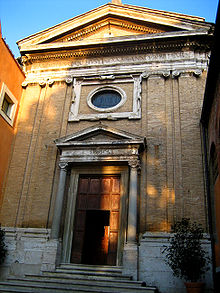 [Latin] Ecclesia Domestica: House Church, domestic church; Acts 2:42,46
[Latin] Ecclesia Domestica: House Church, domestic church; Acts 2:42,46
Background:
At this time, Christianity, as a practicing religion, was still against the law. The Christians gathered in their homes. This was the place of assembly, worship, prayer, and the celebration of the Mass. The congregants entered the house through the vestiblum (vestibule), entering into the atrium (court area). The impluvium (pool) was most likely used for washing hands and baptism. A compluvium (central opening in the roof) let in air and light in the atrium. A sloping roof carried water in the pool.
The small number of congregants would gather in the tablinum (office). This is the room where the bishop or priest would preside over the Eucharist. As the number congregants increased, the excess of attendees would gather in the atrium and peristylum (courtyard) surrounding the atrium.
The roof (compluvium) let in air and light in the atrium. A sloping roof carried water into the pool. The church community gathered in the triclinium (dining room) for a meal before worship. After dinner, services were held in the tablinum (office). If the group was large, the extra visitors would gather in atrium and courtyard (peristylum).

Typical layout of a Roman house

House of Pudents: Some have claimed that this is the oldest place of Christian worship in Rome. The later St. Pudenziana church was
built over the 2nd century house, during the pontificate of Pius I (140-155 AD). This church was residence of the pope until 313 AD, until Emperor Constantine offered the papacy the Lateran Palace. This was also a tradition that Peter, Paul, and Mark may have lived at different times at this house.
A very old tradition, confirmed by the Liber Pontificalis, describes the modern church St. Pudenziana as the place where Pudens was baptized by the Apostles. It also suggested that the chair used by St. Peter was located here in this house church.
Scripture:
“They devoted themselves to the teaching of the apostles and to the communal life, to the breaking of the bread and to the prayers….Every day they devoted themselves to meeting together in the temple area and to breaking bread n their homes.” Acts 2:42,46
This scripture passage shows that they celebrated Mass in the home.
Inside the city of Rome, there exists authentic houses of prayer. There are five names that can be associated with Peter and Paul’s time in Rome. The House of Pudens was led by Senator Cornelius Pudens. His daughters were Pudentia and Praxedes. The House of Prisca consists of Priscilla and Aquila.

House of Prisca: Prisca may have belonged to one of the prominent families of Rome. Jewish tentmakers by trade, Prisca and Aquila, were banished from Rome by the edict of Emperor Claudius. Prisca and Aquila later joined with Paul’s ministry in Corinth. She became a pupil of Paul. Paul’s letter to the Romans indicates that Prisca and Aquila later returned to Rome and established yet another house church there. Rom 16:3-4. St. Prisca Church was later built over a house church.
.
Possible relationship/connection between Pudens family and Prisca: As a rule, early Roman churches were built above the houses attached to the names, going back to 145 AD. Under the floor of St. Prisca, a bronze tablet showed the date of 224 AD. The inscription on the tablet mentions the name of another Roman senator of a prominent Roman family. His name was Caius Marius Pudens Cornelianus. It has also been shown that the Cemetery of Priscilla, was on a site belonging to the Pudens family. So they must have shared the same cemetery.
Scripture:
“Try to get here before winter. Eubulus, Pudens, Linus, Claudia, and all the brothers send greetings.” 2Tim. 4:21
Here is scriptural evidence that Paul knew Pudens. Linus is known to be the Peter’s successor as pope.
“Aquila and Prisca together with the church at their house send you many greeting in the Lord.” 1 Cor.16:19
Scripture show that Aquila and Prisca had a church house.
Conclusion:
The components of the early house church later come the blueprint for the modern church. The tablinum becomes the apse of the church. The atrium becomes the nave of the church. The side wings of the peristyle becomes the aisles of the church. This confirms the idea that a church structure existed before established scripture.
It is also very interesting note that the Apostles Peter and Paul can be connected with the church houses. Tradition in addition to scripture provides a broader and clearer picture of the early church.
